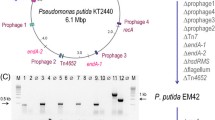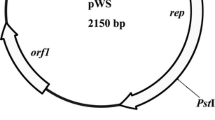Abstract
Members of the genus Paenibacillus are widespread facultative anaerobic, endospore-forming bacteria. Some species such as Paenibacillus riograndensis or Paenibacillus polymyxa fix nitrogen and may play an important role in agriculture to reduce mineral nitrogen fertilization in particular for non-legume plants. The genetic manipulation of Paenibacillus is an imperative for the functional characterization, e.g., of its plant growth-promoting activities and metabolism. This study showed that P. riograndensis and P. polymyxa can be readily transformed using physical permeation by magnesium aminoclays. By means of the fluorescent reporter genes gfpUV, mcherry, and crimson, a two-plasmid system consisting of a theta-replicating plasmid and a rolling circle-replicating plasmid was shown to operate in both species. Xylose-inducible and mannitol-inducible fluorescent reporter gene expression was demonstrated in the compatible two-plasmid system by fluorescence-activated cell scanning. As a metabolic engineering application, the biotin requiring P. riograndensis was converted to a biotin-prototrophic strain based on mannitol-inducible expression of the biotin biosynthesis operon bioWAFDBI from Bacillus subtilis.






Similar content being viewed by others
References
Adlakha N, Shams S (2015) Efficient production of (R, R)-2, 3-butanediol from cellulosic hydrolysate using Paenibacillus polymyxa ICGEB2008. J Ind Microbiol Biotechnol 42:21–28. doi:10.1007/s10295-014-1542-0
Altschul SF, Gish W, Miller W, Myers EW, Lipman DJ (1990) Basic local alignment search tool. J Mol Biol 215:403–410
Bakhiet N, Stahly DP (1985) Studies on transfection and transformation of protoplasts of Bacillus larvae, Bacillus subtilis, and Bacillus popilliae. Appl Environ Microbiol 49:577–581
Becker J, Schäfer R, Kohlstedt M, Harder BJ, Borchert NS, Stöveken N, Bremer E, Wittmann C (2013) Systems metabolic engineering of Corynebacterium glutamicum for production of the chemical chaperone ectoine. Microb Cell Factories 12:110. doi:10.1186/1475-2859-12-110
Beneduzi A, Costa PB, Melo IS, Bodanese-zanettini MH, Passaglia LMP (2010) Paenibacillus riograndensis sp. nov ., a nitrogen- fixing species isolated from the rhizosphere of Triticum aestivum. Int J Syst Evol Microbiol 60:128–133. doi:10.1099/ijs.0.011973-0
Beneduzi A, Moreira F, Costa PB, Vargas LK, Lisboa BB, Favreto R, Ivo J, Maria L, Passaglia P (2013) Diversity and plant growth promoting evaluation abilities of bacteria isolated from sugarcane cultivated in the south of Brazil. Appl Soil Ecol 63:94–104. doi:10.1016/j.apsoil.2012.08.010
Biedendieck R, Borgmeier C, Bunk B, Stammen S, Scherling C, Meinhardt F, Wittmann C, Jahn D (2011) Systems biology of recombinant protein production using Bacillus megaterium. Methods Enzymol 500:165–195. doi:10.1016/B978-0-12-385118-5.00010-4
Brito LF, Bach E, Kalinowski J, Rückert C, Wibberg D, Passaglia LM, Wendisch VF (2015) Complete genome sequence of Paenibacillus riograndensis SBR5, a gram-positive diazotrophic rhizobacterium. J Biotechnol 207:30–31. doi:10.1016/j.jbiotec.2015.04.025
Choi HA, Lee YC, Lee JY, Shin HJ, Han HK, Kim GJ (2013) A simple bacterial transformation method using magnesium- and calcium-aminoclays. J Microbiol Methods 95:97–101. doi:10.1016/j.mimet.2013.07.018
Cleto S, Jensen JK, Wendisch VF, Lu TK (2016) Corynebacterium glutamicum metabolic engineering with CRISPR interference (CRISPRi). ACS Synth Biol 5:375–385. doi:10.1021/acssynbio.5b00216
Datsenko KA, Wanner BL (2000) One-step inactivation of chromosomal genes in Escherichia coli K-12 using PCR products. Proc Natl Acad Sci 97:6640–6645. doi:10.1073/pnas.120163297
Eikmanns BJ, Thum-schmitz N, Eggeling L, Ludtke K, Sahm H (1994) Nucleotide sequence, expression and transcriptional analysis of the Corynebacterium glutamicum gltA gene encoding citrate synthase. Microbiology 140:1817–1828. doi:10.1099/13500872-140-8-1817
Fernandes GDC, Trarbach LJ, Campos SB De, Beneduzi A, Passaglia LMP (2014) Alternative nitrogenase and pseudogenes : unique features of the Paenibacillus riograndensis nitrogen fixation system. Res Microbiol 165:571–580. doi: 10.1016/j.resmic.2014.06.002
Gibson DG (2014) Programming biological operating systems: genome design, assembly and activation. Nat Methods 11:521–526. doi:10.1038/nmeth.2894
Han HK, Lee YC, Lee MY, Patil AJ, Shin HJ (2011) Magnesium and calcium organophyllosilicates: synthesis and in vitro cytotoxicity study. ACS Appl Mater Interfaces 3:2564–2572. doi:10.1021/am200406k
Hanahan D, Harbor CS (1983) Studies on transformation of Escherichia coli with plasmids. J Mol Biol 166:557–580
Hanahan BD, Jessee J (1991) Plasmid transformation of Escherichia coli and other bacteria. Methods Enzymol 204:63–113
Heggeset TMB, Krog A, Balzer S, Wentzel A, Ellingsen TE, Brautaset T (2012) Genome sequence of thermotolerant Bacillus methanolicus: features and regulation related to methylotrophy and production of L-lysine and L-glutamate from methanol. Appl Environ Microbiol 78:5170–5181. doi:10.1128/AEM.00703-12
Heravi KM, Altenbuchner J (2016) Regulation of the Bacillus subtilis mannitol utilization genes: promoter structure and transcriptional activation by the wild-type regulator (MtlR) and its mutants. Microbiology 160:91–101. doi:10.1099/mic.0.071233-0
Ikeda M, Miyamoto A, Mutoh S, Kitano Y, Tajima M, Shirakura D, Takasaki M (2013) Development of biotin-prototrophic and-hyperauxotrophic Corynebacterium glutamicum strains. Appl Environ Microbiol 79:4586–4594. doi:10.1128/AEM.00828-13
Irla M, Neshat A, Brautaset T, Rückert C, Kalinowski J, Wendisch VF (2015) Transcriptome analysis of thermophilic methylotrophic Bacillus methanolicus MGA3 using RNA-sequencing provides detailed insights into its previously uncharted transcriptional landscape. BMC Genomics 16:1–22. doi:10.1186/s12864-015-1239-4
Irla M, Heggeset TMB, Nærdal I, Paul L, Tone H, Le SB, Brautaset T, Wendisch VF (2016) Genome-based genetic tool development for Bacillus methanolicus: theta- and rolling circle-replicating plasmids for inducible gene expression and application to methanol-based cadaverine production. Front Microbiol 7:1481. doi:10.3389/fmicb.2016.01481
Jakobsen OM, Brautaset T, Degnes KF, Heggeset TMB, Balzer S, Flickinger MC, Valla S, Ellingsen TE (2009) Overexpression of wild-type aspartokinase increases L-lysine production in the thermotolerant methylotrophic bacterium. Appl Environ Microbiol 75:652–661. doi:10.1128/AEM.01176-08
Jiang W, Marraffini LA (2015) CRISPR-Cas: new tools for genetic manipulations from bacterial immunity systems. Annu Rev Microbiol 69:209–228. doi: 10.1146/annurev-micro-091014-104441
Jitrapakdee S, Wallace JC (2003) The biotin enzyme family: conserved structural motifs and domain rearrangements. Curr Protein Pept Sci 4:217–229
Jones PD, Graham V, Segal L, Baillie WJ, Briggs MH (1962) Forms of soil biotin. Life Sci 1:645–648
Khlebnikov A, Datsenko KA, Skaug T, Wanner BL, Keasling JD (2016) Homogeneous expression of the PBAD promoter in Escherichia coli by constitutive expression of the low-affinity high-capacity AraE transporter. Microbiology 147:3241–3247. doi:10.1099/00221287-147-12-3241
Kim S, Lee YC, Cho DH, Lee HU, Huh YS, Kim GJ, Kim HS (2014) A simple and non-invasive method for nuclear transformation of intact-walled Chlamydomonas reinhardtii. PLoS One 9:e101018. doi:10.1371/journal.pone.0101018
Leonhardt H (1990) Identification of a low-copy-number mutation within the pUB II0 replicon and its effect on plasmid stability in Bacillus subtilis. Gene 94:121–124
Leonhardt H, Alonso JC (1991) Parameters affecting plasmid stability in Bacillus subtilis. Gene 103:107–111
Makarova KS (2011) Evolution and classification of the CRISPR–Cas systems. Nat Rev Microbiol 9:467–477. doi:10.1038/nrmicro2577
Murray KD, Aronstein KA (2008) Transformation of the gram-positive honey bee pathogen, Paenibacillus larvae, by electroporation. J Microbiol Methods 75:325–328. doi:10.1016/j.mimet.2008.07.007
Nguyen HD, Nguyen QA, Ferreira RC, Ferreira LCS, Tran LT, Schumann W (2005) Construction of plasmid-based expression vectors for Bacillus subtilis exhibiting full structural stability. Plasmid 54:241–248. doi:10.1016/j.plasmid.2005.05.001
Pátek M, Nešvera J (2011) Sigma factors and promoters in Corynebacterium glutamicum. J Biotechnol 154:101–113. doi:10.1016/j.jbiotec.2011.01.017
Peters-Wendisch P, Götker S, Heider SAE, Reddy GK, Nguyen AQ, Stansen KC, Wendisch VF (2014) Engineering biotin prototrophic Corynebacterium glutamicum strains for amino acid, diamine and carotenoid production. J Biotechnol 192:346–354. doi:10.1016/j.jbiotec.2014.01.023
Rim H, Soo K, Park Y, Bin S, Jeong H, Keun S, Seung C, Park H (2014) Inactivation of the phosphoglucomutase gene pgm in Paenibacillus polymyxa leads to overproduction of fusaricidin. J Ind Microbiol Biotechnol 41:1405–1414. doi:10.1007/s10295-014-1470-z
Rosado A, Duarte GF, Seldin L (1994) Optimization of electroporation procedure to transform B. polymyxa SCE2 and other nitrogen-fixing Bacillus. J Microbiol Methods 19:1–11. doi:10.1016/0167-7012(94)90020-5
Sambrook J (2001) Molecular cloning: a laboratory manual, 3rd edn. Cold Spring Harbor Laboratory press, New York
Solovyev V, Salamov A (2011) Automatic annotation of microbial genomes and metagenomic sequences. In: Li RW (ed) Metagenomics and its applications in agriculture, biomedicine and environmental studies. Nova Science Publishers, pp 61–78
Sperb ER, Tadra-Sfeir MZ, Sperotto RA, Fernandes Gde C, Pedrosa Fde O, de Souza EM, Passaglia LM (2016) Iron deficiency mechanisms enlightened by gene expression analysis in Paenibacillus riograndensis SBR5. Res Microbiol 167:501–509. doi:10.1016/j.resmic.2016.04.007
Tong Y, Charusanti P, Zhang L, Weber T, Lee SY (2015) CRISPR-Cas9 based engineering of actinomycetal genomes. ACS Synth Biol 4:1020–1029. doi:10.1021/acssynbio.5b00038
Yoshida N, Sato M (2009) Plasmid uptake by bacteria: a comparison of methods and efficiencies. Appl Microbiol Biotechnol 83:791–798. doi:10.1007/s00253-009-2042-4
Yoshida N, Ikeda T, Yoshida T, Sengoku T, Ogawa K (2001) Chrysotile asbestos fibers mediate transformation of Escherichia coli by exogenous plasmid DNA. FEMS Microbiol Lett 195:133–137. doi:10.1016/S0378-1097(00)00564-4
Yu B, Sun J, Bommareddy RR, Song L, Zeng A (2011) Novel (2R, 3R)-2, 3-butanediol dehydrogenase from potential industrial strain Paenibacillus polymyxa ATCC 12321. Appl Environ Microbiol 77:4230–4233. doi:10.1128/AEM.02998-10
Acknowledgements
L.F.B. acknowledges financial support from Coordenação de Aperfeiçoamento de Pessoal de Nível Superior (Science without Borders program), Brazil. M.I. acknowledges support from the CLIB Graduate Cluster Industrial Biotechnology at Bielefeld University, Germany which is financed by a grant from the Federal Ministry of Innovation, Science and Research (MIWF) of the federal state North Rhine-Westphalia, Germany.
Author information
Authors and Affiliations
Corresponding author
Ethics declarations
Conflict of interest
The authors declare that they have no conflict of interest.
Ethical approval
The research performed did not involve human participants and/or animals.
Electronic supplementary material
ESM 1
(PDF 303 kb)
Rights and permissions
About this article
Cite this article
Brito, L.F., Irla, M., Walter, T. et al. Magnesium aminoclay-based transformation of Paenibacillus riograndensis and Paenibacillus polymyxa and development of tools for gene expression. Appl Microbiol Biotechnol 101, 735–747 (2017). https://doi.org/10.1007/s00253-016-7999-1
Received:
Revised:
Accepted:
Published:
Issue Date:
DOI: https://doi.org/10.1007/s00253-016-7999-1




